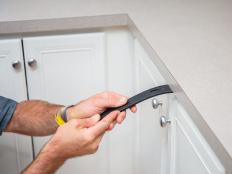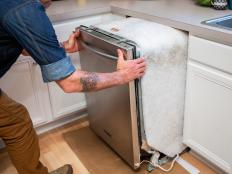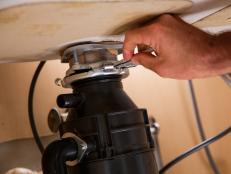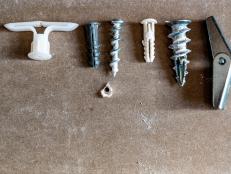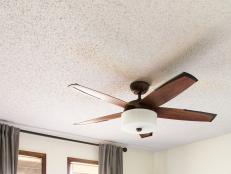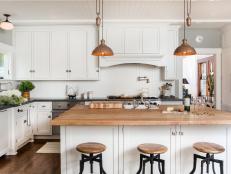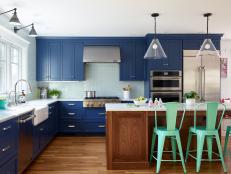Demolition: Cabinets and Countertops
Cabinet "demolition" is a DIY-friendly project. There are two routes to take when blowing out a room full of cabinets and counters: You can go ballistic—what I call the full-bore technique—or be more methodical and deconstruct the space. The route you choose will depend on the scope of the project. Whichever way you trundle, both roads start at the same place.
Removing counters and cabinets is easiest if you don't have to worry about water and electrical wires. Sometimes you can shut the water off in the basement or another shut-off location. If there's no shut-off there, check right below the fixture. After terminating the supply, drain the pipes leading into the fixtures by opening the valves. If you'll be moving or removing electrical devices, disconnect the power. It's a critical step.
Here's where the routes diverge:
Technique 1: Full Bore
I recommend this technique only if two conditions exist: You're ripping the room back to studs or block, and you have a Dumpster to contain all the debris. If so, grab your breaker bar and go to town (safely, of course). Pry or smash the cabinets off the wall, rip up the counter and let the pieces fall where they may. Have fun.
Technique 2: Installation in Reverse
If, like most people, you're in what I call a "remove and replace" situation—i.e., you want to lose the existing cabinets and countertop but keep the room they're in—then using installation techniques in reverse—deconstruction—is the key to smart removal that will leave a usable substrate. Here's how to tackle each component of the job:
Floors. If you're saving the floors, cover them with ¼-inch plywood or cardboard to protect them from the tool, cabinet or cuppa Joe just waiting to fall on them.
Fixtures. Organize your wrenches and pliers for disconnecting faucets, hoses, garbage disposals, etc. If you're saving the faucets, a basin wrench is key for accessing faucet hardware.
Counters and shoe. Tackle the countertops from both the top and beneath. Topside, cut through any caulk or paint between the countertop and the wall or backsplash with a utility knife. This will help you keep from pulling out chunks of plaster or paper facing from drywall when you pull out the counter.
Next, crawl under the cabinets and remove the screws located in the corner webbing or corner blocks of the base cabinets that hold the counter in place.
If needed, get a helper and lift the countertop off the base cabinets and haul it outdoors. If you're alone or the countertop is huge, either disassemble the pieces (hardware usually holds laminate sections together from the bottom) or get a recip saw and cut the counter into sections.
Finally, strip any base or shoe molding between the floor and the toe kick of the cabinet box.
Base units. With the counters off, pull open drawers and remove the upper set of screws holding the base cabinets to the wall.
Next, close the drawers and open the doors to remove the lower screws. Note: You should find about four screws, roughly one in each corner of the cabinet's back panel.
Now remove the face-frame screws. Each cabinet box is probably screwed to its adjoining cabinet box(es) with trim drive screws through the face frames. Removing these should free the cabinets.
Islands. Islands may be connected by nails or screws you'll find behind the shoe or base molding. They're driven into 2-by-4 blocking applied to the floor beneath the cabinets. If you find screws here, remove them and lift the cabinets off the 2-by. If they're nailed, pry the cabinet boxes up with a flat bar. It won't be pretty, but they'll come off.
Uppers. Start removing the uppers by fastening a 1-by-4 or 2-by-4 ledger board to the wall beneath them. Make sure to catch studs with the screws.
Next, remove the face-frame screws, and then get the lower screws that hold the cabinet to the wall. Now, preferably from a ladder unless you're very tall, remove the top wall screws from the rear cabinet panel. As you do this, the cabinet box will come free. Pressing the box to the wall will keep it from tipping, and the ledger will keep it from falling straight down. Either have a helper take it from you or lower it to the floor yourself.
Other Tips:
- Be orderly. As you remove cabinets, get them out of the work area.
- Light the space. If you've shut off the electricity, use work lights.
- Think about recycling the cabinets, maybe for use as garage storage.
- Countertops can make nice desktop slabs or workbenches.
- Check local charities to see if you can donate the old units.
- As you deconstruct your cabinets, pay attention to how they were installed in the first place. It's like a basic training course on cabinet installation.
Mark Clement is a remodeler and author of The Carpenter's Notebook and The Kid's Carpenter's Workbook, Fun Family Projects! Find out more at www.TheCarpentersNotebook.com.






